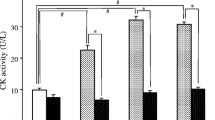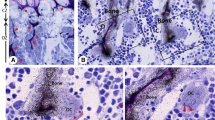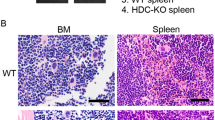Summary
Aminoalkyl derivatives of bisphosphonates are potent inhibitors of bone resorption. A single I.P. injection of 4-amino-1-hydroxybutylidene-1,1-bis-phosphonate (AHBuBP) induced a prolonged enhancement of histidine decarboxylase (HDC) activity in the bone marrow, spleen, lung, and liver of mice and resulted in an increase in histamine. The induction of HDC by the agent was dose dependent (16–80 μmol/kg) and peaked 3–4 days after its injection (40 μmol/kg). Repeated S.C. injections of smaller doses of AHBuBP (0.32 or 1.6 μmol/kg/day) for 4 days also enhanced HDC activity. However, the minimum dose capable of inhibiting bone resorption (0.064 μmol/kg/day) was lower than that inducing HDC. Unexpectedly, AHBuBP, at the doses inducing HDC, increased macrophages, granulocytes, and even osteoclasts. The size of osteoclasts was also enlarged by the agent. Another aminobisphosphonate, 3-amino-1-hydroxypropylidene-1,1-bisphosphonate, but none of nonamino derivatives, also exhibited essentially the same effects as those of AHBuBP. These results indicate that in spite of increase in osteoclasts and their enlargement, bone resorption is still inhibited by amino bisphosphonates. As granulocyte and granulocyte-macrophage colony-stimulating factors and interleukin-3 induce HDC in hematopoietic organs, and histamine has a hematopoietic activity, the HDC induction by aminobisphosphonates may be relevant to the proliferation of progenitor cells of macrophages, granulocytes, and osteoclasts.
Similar content being viewed by others
References
Endo Y (1982) Simultaneous induction of histidine and ornithine decarboxylases and changes in their product amines following the injection of Escherichia coli lipopolysaccharide into mice. Biochem Pharmacol 31:1643–1647
Endo Y (1983) Induction of histidine decarboxylase in mouse tissues by mitogens in vivo. Biochem Pharmacol 32:3825–3838
Endo Y (1989) Induction of histidine and ornithine decarboxylase activities in mouse tissues by recombinant interleukin-1 and tumor necrosis factor. Biochem Pharmacol 38:1287–1292
Dinarello CA (1989) Interleukin-1 and its biologically related cytokines. Adv Immunol 44:153–205
Endo Y, Suzuki R, Kumagai K (1986) Macrophages can produce factors capable of inducing histidine decarboxylase, a histamine-forming enzyme, in vivo in the liver, spleen, and lung of mice. Cell Immunol 97:13–22
Chambers TJ (1980) Diphosphonates inhibit bone resorption by macrophages in vitro. J Pathol 132:255–262
Rooijen NV, Nieuwmegen RV (1984) Elimination of phagocytic cells in the spleen after intravenous injection of liposome-encapsulated dichloromethylene diphosphonate. Cell Tissue Res 238:355–358
Thepen T, Rooijen NV, Kraal G (1989) Alveolar macrophage elimination in vivo is associated with an increase in pulmonary immune response in mice. J Exp Med 170:499–509
Schenk R, Eggli P, Fleisch H, Rosini S (1986) Quantitative morphometric evaluation of the inhibitory activity of new aminobisphosphonates on bone resorption in the rat. Calcif Tissue Int 38:342–349
Endo Y (1983) A simple method for the determination of polyamines and histamine and its application to the assay of ornithine and histidine decarboxylase activities. Methods Enzymol 94:42–47
Endo Y, Kikuchi T, Nakamura M, Shinoda H (1992) Determination of histamine and polyamines in calcified tissues of mice: contribution of mast cells and histidine decarboxylase to the amount of histamine in the bone. Calcif Tissue Int 51:67–71
Yam LT, Li CY, Crosby WH (1971) Cytochemical identification of monocytes and granulocytes. Am J Clin Pathol 55:283–290
Fleisch H, Russell RGG, Francis MD (1969) Diphosphonates inhibit hydroxyapatite dissolution in vitro and bone resorption in tissue culture in vivo. Science 165:1262–1264
Francis MD, Russell RGG, Fleisch H (1969) Diphosphonates inhibit formation of calcium phosphate crystals in vitro and pathological calcification in vivo. Science 165:1264–1266
Jung A, Bisaz S, Fleisch H (1973) The binding of pyrophosphates by hydroxyapatite crystals. Calcif Tissue Res 11:269–280
Schenk R, Merz WA, Mühlbauer R, Russell RGG, Fleisch H (1973) Effect of ethan-1-hydroxyl-1,1-diphosphonate (EHDP) and dichloromethylene diphosphonate (Cl2MDP) on the calcification and resorption of cartilage and bone in the tibial epiphysis and metaphysis of rats. Calcif Tissue Res 11:196–214
Flanagan AM, Chambers TJ (1989) Dichloromethylenebisphosphonate (Cl2MBP) inhibits bone resorption through injury to osteoclasts that resorb Cl2MBP-coated bone. Bone Miner 6:33–43
Cecchini MG, Felix R, Fleisch H, Cooper PH (1987) Effects of bisphosphonates on proliferation and viability of mouse bone marrow-derived macrophages. J Bone Miner Res 2:135–142
Hughes GE, MacDonald BR, Russell RGG, Gowen M (1989) Inhibition of osteoclast-like cell formation by bisphosphonates in long-term cultures of human bone marrow. J Clin Invest 83: 1930–1935
Carano A, Teitelbaum SL, Konsek JD, Schlesinger PH, Blair HC (1990) Bisphosphonates directly inhibit bone resorption activity of isolated avian osteoclasts in vitro. J Clin Invest 85:456–461
Sato M, Grasser W, Endo N, Atkins R, Simmons H, Thompson DD, Gloub E, Rodan GA (1991) Bisphosphonate action: alendronate localization in rat bone and osteoclast ultrastructure. J Clin Invest 88:2095–2105
Reitsma PH, Teitelbaum SL, Bijvoet OLM, Kahn AJ (1982) Differential action of the bisphosphonates (3-amino-1-hydroxypropylidene)-1,1-bisphosphonate (APD) and disodium dichloromethylidene bisphosphonate (Cl2MDP) on rat macrophage-mediated bone resorption in vitro. J Clin Invest 70:927–933
Rooijen NV, Kors N (1989) Effects of intracellular diphosphonates on cells of the mononuclear phagocyte system: in vivo effects of liposome-encapsulated diphosphonates on different macrophage subpopulation in the spleen. Calcif Tissue Int 45: 153–156
Fujimoto R, Nii A, Okazaki A, Miki H, Kawashima H (1990) Effect of disodium dihydrogen (cycloheptylamino) methylene bisphosphonates (YM175) on the bone formation and resorption in rats and dogs. Histological examination. XIth Ann Meeting Am Soc Bone Mineral Res, August 28–31, Atlanta, Georgia, USA
Byron JW (1977) Mechanism for histamine H2 receptor-induced cell-cycle changes in the bone marrow stem cell. Agents and Actions 7:209–213
Shounan Y, You-Heng X (1988) The influence of histamine at various concentrations on the cell cycle state of hematopoietic stem cells (CFU-s). Int J Cell Cloning 6:290–295
Nakaya N, Tasaka K (1988) The influence of histamine on precursors of granulocytic leukocytes in murine bone marrow. Life Sci 42:999–1010
Schneider E, Piquet-Pellorce C, Dy M (1990) New role for histamine in interleukin-3-induced proliferation of hematopoietic stem cells. J Cell Physiol 143:337–343
Lebel B, Schneider E, Piquet-Pellorce C, Machavoine F, Kindler V, Luffau G, Dy M (1990) Antigenic challenge of immunized mice induces endogenous production of IL-3 that increases histamine synthesis in hematopoietic organs. J Immunol 135:1222–1226
Endo Y, Kikuchi T, Takeda Y, Nitta Y, Rikiiski H, Kumagai K (1992) GM-CSF and G-CSF stimulate the synthesis of histamine and putrescine in the hematopoietic organs in vivo. Immunol Lett 33:9–14
Adami S, Bhalla AK, Dorizzi R, Montesanti F, Rosini S, Salvagno G, Lo Casio V (1987) The acute-phase response after bisphosphonate administration. Calcif Tissue Int 41:326–331
Author information
Authors and Affiliations
Rights and permissions
About this article
Cite this article
Endo, Y., Nakamura, M., Kikuchi, T. et al. Aminoalkylbisphosphonates, potent inhibitors of bone resorption, induce a prolonged stimulation of histamine synthesis and increase macrophages, granulocytes, and osteoclasts in vivo . Calcif Tissue Int 52, 248–254 (1993). https://doi.org/10.1007/BF00298728
Received:
Revised:
Issue Date:
DOI: https://doi.org/10.1007/BF00298728




